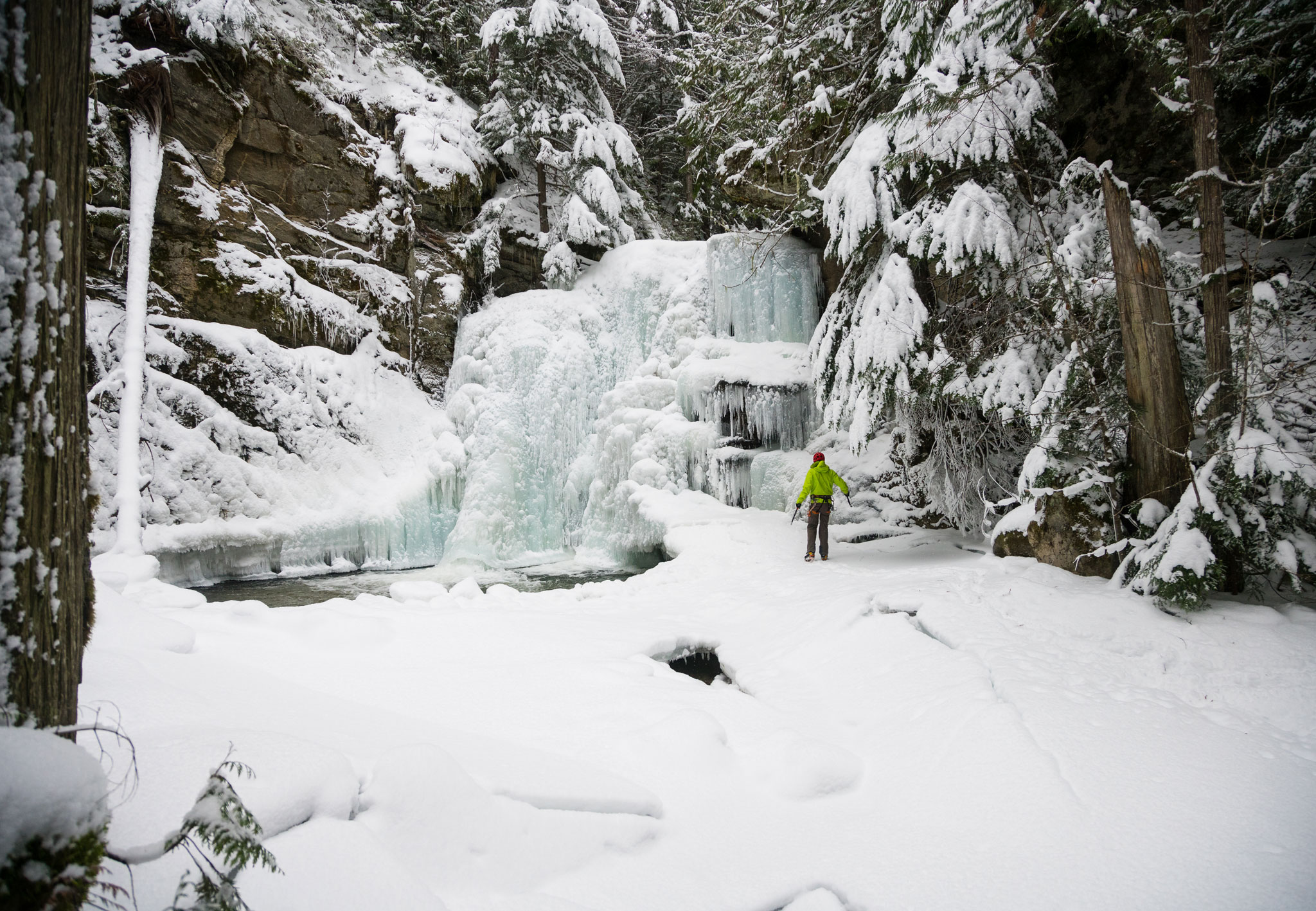After a final gear check, I pull up the weather. It’s as I expected. Heavy snow and wind. Fifteen degrees. A blizzard, basically. It’s 3 a.m. Should be a fantastic drive.
I say goodbye to my lady and the dog, both of them curled up in bed, oblivious to my rumblings around the house. Then, I head out into the weather, stoked because not only is this great weather for ice climbing, but I’m reminded of just how much I love winter and the cold.

After a quick stop for the ritualistic pre-adventure breakfast burrito and soccer mom-esque coconut water, I get on the road. Thankfully, the drive to Sandpoint is mostly uneventful, and when I arrive at my buddy’s house his truck is already warming up. We toss all of our gear in and head for Clark Fork and some epic ice formations just outside of town.
It’s a short hike through thigh-deep snow to a spot along the highway directly below our objective. Above us is a beautifully ominous, turquoise column of frozen water tucked in around a towering corner of rock. This is exactly what we have come to climb. And it looks fat! However, the icicle is 500 feet up on the top of the cliff-like, scree-and-snow covered mountain. We plot a rough path up before crossing the highway.
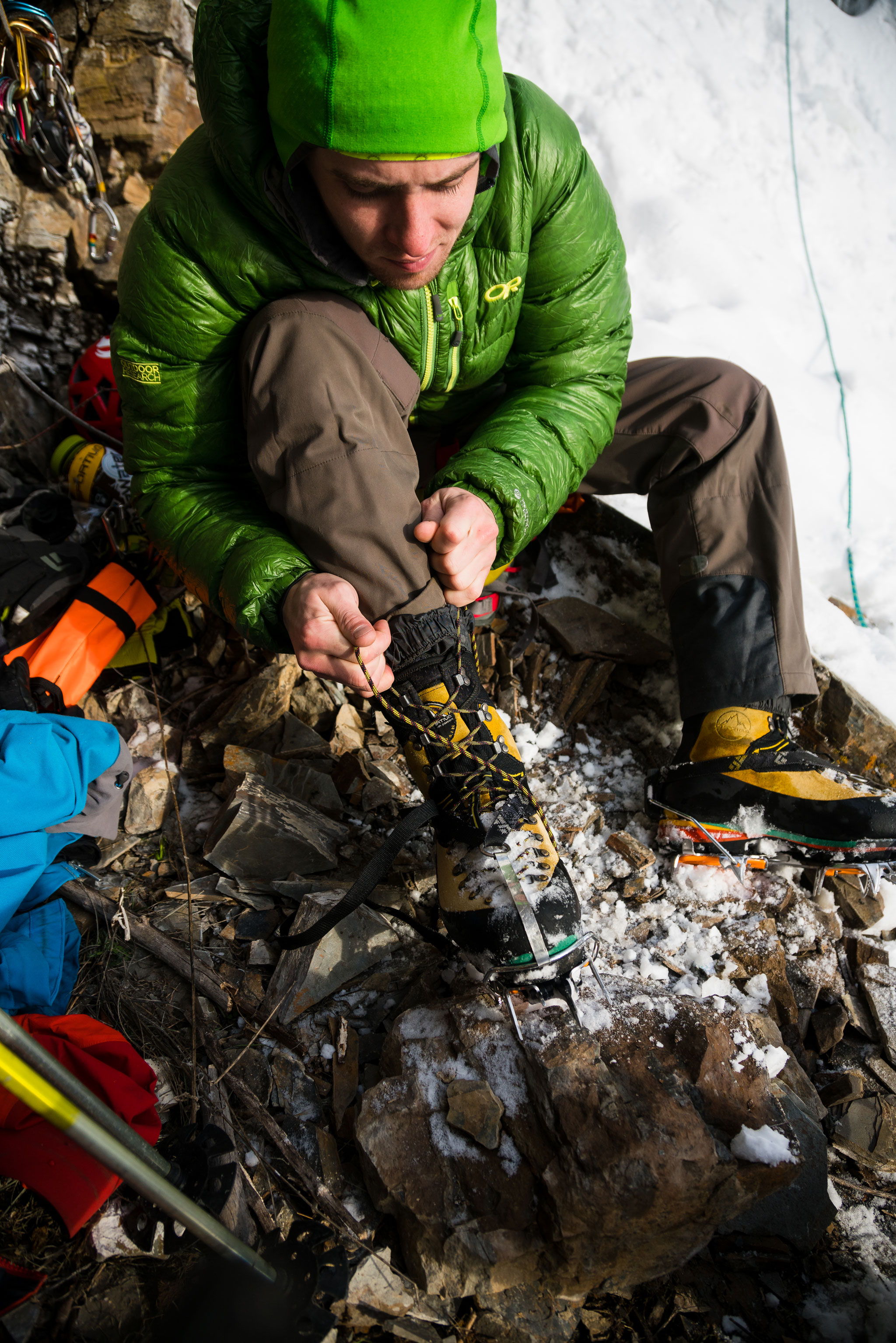
The climbing is brutal. There isn’t enough snow on the scree to kick steps, much less provide stable footing with 50 pounds of gear on our backs. On the bright side, the blizzard seems to have tapered off and we can see more than 50 feet. We continue climbing, clawing and grasping our way to our goal.
We finally reach the base of the ice and the sufferfest of the last hour quickly fades away. We start gearing up just as the sun breaks through the clouds. The cliffs and trees, covered in fresh snow, seem to explode like billions of diamonds in the sunlight. We empty our bags onto the ground, breaking the silence with the unique clatter of ice screws, carabiners and belay devices. They clang and clatter against each other and the pottery-like rocks around the small ledge we are perched on 500 feet off the ground.
With 20 pounds of razor-sharp metal objects now hanging from my waist, I tie into the rope. My buddy Ben double checks my knot and his belay setup. I swallow hard and take a deep breath, nervous about lead climbing this monster ice flow that extends above me some 100 feet.
Story continues after a quick message from our sponsor below.
I step forward toward the column. The hardware hanging off my harness sounds like a gypsy camp rattling and clanging through the mountains. An ice tool held firmly in each hand, I exhale. My breath hovers in a bright cloud in front of me and slowly drifts off. I quickly survey the ice. It is feature-loaded; vertical valleys, knobs, small ledges and mushroom-looking formations adorn the bullet-hard wall. I spot a small pocket in the ice about two feet above my head, raise my ice tool and swing. With a quick fl ick of my wrist I sink the hardened steel of the pick into the ice under a shower of shards. I give it a quick tug to make sure it will bear my weight. Then, I scan for another spot to the left. I fi nd just what I am looking for. This time the tool hits the ice and splits a large chunk off the face along with the usual plethora of tiny ice daggers, all seemingly hell-bent on sticking me in the face. I turn my head to let my helmet catch the brunt of the shower. The tool does not stick. Two swings later, I get a good placement. Part of the thrill of ice climbing is recognizing that no matter where you’ve climbed – we’ve recently done Snow Creek, Lion Creek, Harrison Peak – the ice can be very different. Waterfall ice versus spray ice versus seep ice. They all react and behave differently, forcing you to pay attention.

Hanging straight-armed from the ice axes, I look down at my feet, step up and kick my crampons into the ice at knee level. I inhale. The frigid air burns my nostrils and lungs. Then, I pull up and stand on my toes. I repeat the process with my left foot, taking special care not to catch my pant leg with the sharp stainless spikes as they sink firmly into the ice. Looking up, I search for my next ice tool placement, simultaneously wiggling my left tool loose. It makes a creaking sound, like when slowly biting down on an ice cube. My next swing penetrates the blue ice above me. It sounds like a taut drum and I brace for a potential fall. A crack shoots out from under the pick, zigzagging around air bubbles trapped inside and extending about a foot down the ice. Surprisingly, the tool sticks. I look below to the rope hanging free. Ben is on belay, watching my every move, waiting to keep me safe if I fumble.
I take another deep breath and let go of the ice axe in my right hand, leaving it unmanned on the ice. I look down again, this time to my harness and flip through my rack of ice screws with a couple of gloved fingers. I pull out an ice screw and jab it into a bulge in the ice at waist level, then give it several clockwise twists. The teeth bite firmly and I quickly spin the screw in, a shower of snow cone-like ice spits out the end of the tube as it drives deeper into the column. Once the ice screw is flush to the wall, I close the handle and fumble for a quick-draw off my harness, clip it to the hanger on the screw, and then clip the rope to the free hanging end of the draw. The feeling of safety and comfort, being below my current piece of protection, is short lived and I reach up to my now lonely ice tool. The tool has gotten cold and the leather of my gloves sticks to it. “Oh well,” I tell myself. “It will warm up.” I need to keep moving.
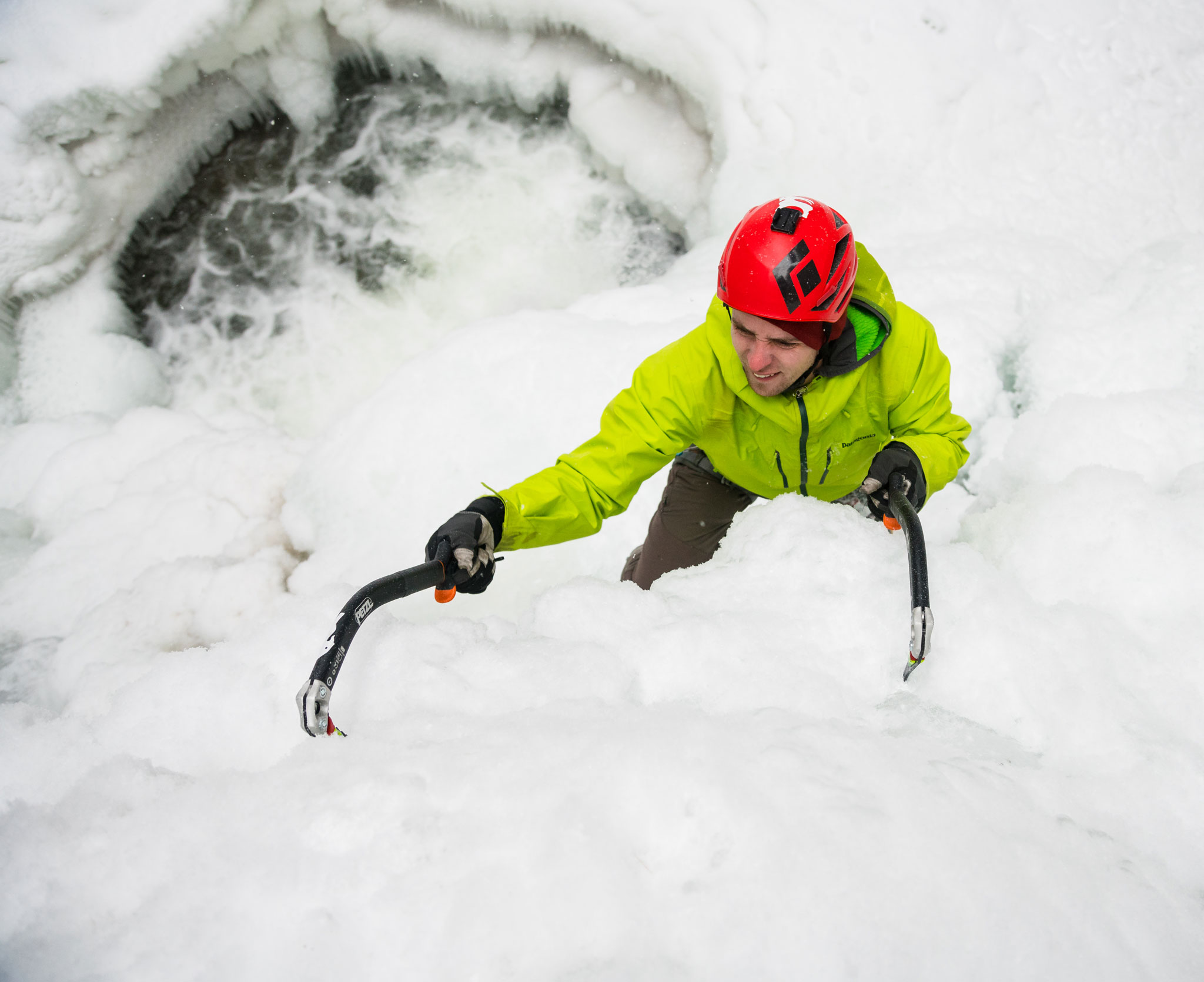
Twenty-five feet higher, and a dozen more placements up the wall, it’s time to place another screw, and I am starting to feel the pump and fatigue in my forearms. “Climb efficiently,” I tell myself. I find a solid placement with my righthand tool and hang, straight-armed off of it away from the wall while simultaneously shaking my left arm and hand out in space to try to alleviate the pump. This climb is definitely harder than anything I’ve climbed recently —maybe ever. At least the ice is thick. Not like Lion Creek, where too deep of a placement would break the ice away and a roaring waterfall would appear 2 inches under the ice.
Ben yells up to me, “Hang in there, dude!” The ice in this section is harder and does not start the screws as easily. Meanwhile my right arm is getting more and more pumped, making it harder to grip the tool that is keeping me from falling 25 feet down to my last piece of protection. The No. 1 rule of ice climbing quickly flashes through my head. Never fall.”
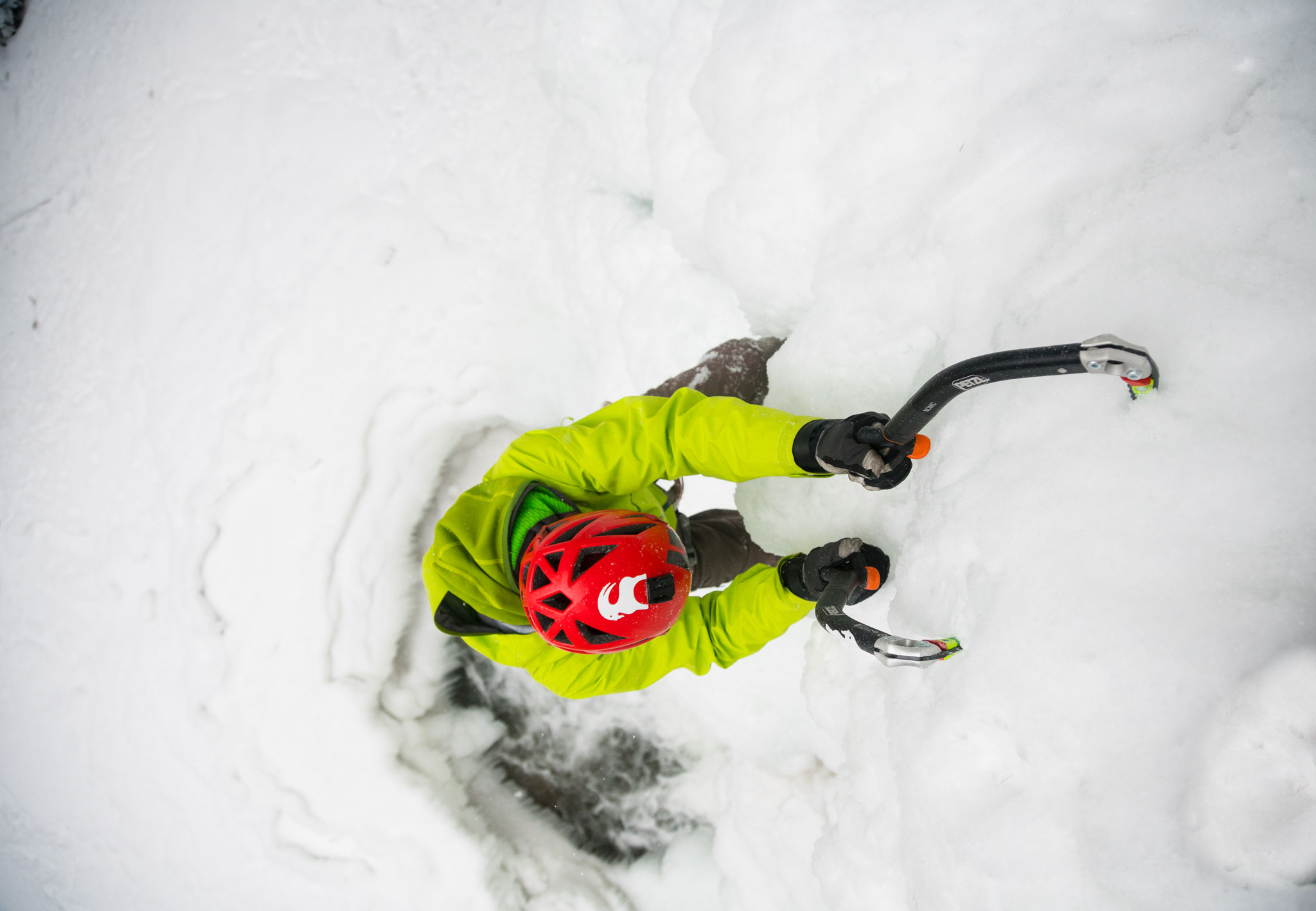
After what seems like an eternity, I finally claw up over the top of the climb. I tie in, using a large tree as my anchor, and yell down to Ben, 100 feet below. “Off Belay!” I rig up a rappel and then back off the top of the cliff. It feels much nicer to rappel off of a solid, live tree rather than the dead snags we found on Harrison Peak. I lower myself down the wall, kicking off occasionally and taking care not to knock any large “deathsickles” down on Ben.
To some, ice climbing is crazy, a fool’s errand. To us, it’s just another day in the neighborhood.
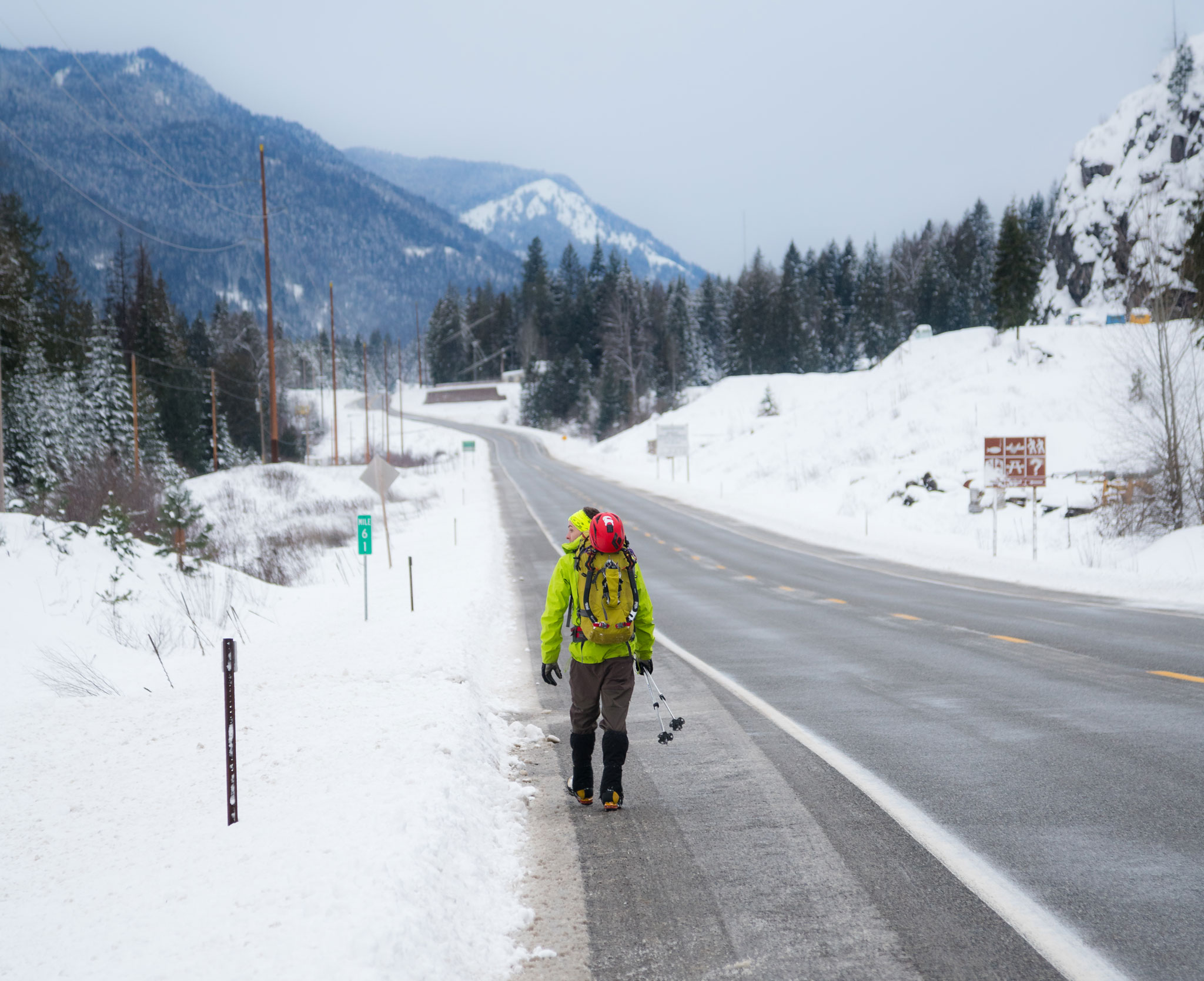
The long walk home.
Story and Photography by Chris Celentano
As Featured In: Winter/Spring 2018


